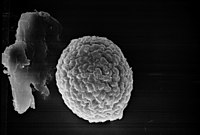Tilletia indica
| Tilletia indica | |
|---|---|
 |
|
| Scientific classification | |
| Kingdom: | Fungi |
| Division: | Basidiomycota |
| Subdivision: | Ustilaginomycotina |
| Class: | Exobasidiomycetes |
| Order: | Tilletiales |
| Family: | Tilletiaceae |
| Genus: | Tilletia |
| Species: | T. indica |
| Binomial name | |
|
Tilletia indica Mitra, (1931) |
|
| Synonyms | |
|
Neovossia indica |
|
Neovossia indica
Karnal bunt (also known as partial bunt) is a fungal disease of wheat, durum wheat, and triticale. The smut fungus Tilletia indica, a basidiomycete, invades the kernels and obtains nutrients from the endosperm, leaving behind waste products with a disagreeable odor that makes bunted kernels too unpalatable for use in flour or pasta. While Karnal bunt generally does not lead to devastating crop losses, it has the potential to dramatically decrease yield and poses additional economic concerns through quarantines which limit the export of suspected infectious wheat products from certain areas, including the U.S. Several chemical control methods exist for Karnal bunt of wheat, but much work remains to be done in identifying resistant host varieties.
Karnal bunt attacks durum wheat, rye, and triticale, a hybrid of wheat and rye. Despite its preference for a common crop, Karnal bunt can be extremely difficult to diagnose in the field for many reasons. First, not all kernels on a plant head will be infected, and thus infected plants are not as readily identifiable. This distribution is the reason for Karnal bunt's being referred to as partial bunt. Another factor which makes Karnal bunt difficult to readily diagnose in the field is the fact that most infected kernels do not show symptoms prior to maturity.
The disease produces dark color and a fishy smell on infected kernels. Usually only the germ end of the kernel will show symptoms, but occasionally the entire kernel may appear diseased. The darkening of the kernel is a result of the kernel tissue being converted in a teleospore mass by the fungus. Another symptom is referred to as the "canoe symptom" as in the process of replacing the healthy kernel with teliospores, the disease tends to hollow out host kernels, resulting in a canoe shape. While the dark teliospores of the fungus may be diagnostic, diagnosis of Karnal bunt poses the added difficulty of differentiating between Karnal bunt from other infections which also result in the aforementioned symptoms, such as black point, common bunt, and dwarf bunt.
The disease is primarily spread through contaminated seed or farm equipment, although it may also be carried short distances by the wind, especially following the burning of wheat fields. Evidence of the importance of airborne dispersal of Tilletia indica was demonstrated by Halasz et al. in 2014 when they discovered a strong correlation between teliospore concentration in the air above a wheat crop and the subsequent number of infected wheat kernels. The researchers concluded that this airborne spread of teliospores could also result in post-harvest disease development The fungal spores can then remain viable for several years, germinating when weather conditions become favorable for development. Once the spores germinate, they infest the wheat flowers and develop large masses of spores on the embryo end of the kernels (the entire kernel is not usually affected).
...
Wikipedia
